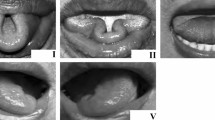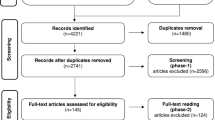Abstract
Objectives
The aim of the study was to identify predictors of the masticatory muscle activity during chewing (MMA) of the masseter and temporalis anterior (TA) muscles in patients with unilateral myogenous temporomandibular disorder (mTMD).
Materials and methods
This observational and cross-sectional study included 109 patients diagnosed with unilateral mTMD. Surface electromyography was used to separately evaluate the MMA of the masseter and TA on the affected and unaffected sides. Also, pain intensity (with a visual analog scale), pressure pain threshold (with an algometer), active pain-free maximum mouth opening and temporomandibular joint lateral movements (with a ruler), cervical range of motions (with a goniometer), and TMD severity (with a Fonseca Anamnestic Index) were assessed. Various statistical methods were used to predict the MMA of the masseter and TA, including standard, forward, and best subsets multiple regression models.
Results
While there were significant correlations between the MMA of the masseter and TA and pain intensity, pressure pain threshold values, and TMD severity, they were not found with other variables. These parameters were also predictive factors for MMA of both muscles (p < 0.05).
Conclusions
According to the present study, pain intensity, muscle and joint tenderness, and the severity of the disorder are predictive factors for MMA of the masseter and TA muscles in patients with mTMD. It is recommended that these parameters be considered when establishing clinical evaluation and treatment programs focusing on MMA in patients with mTMD.
Clinical relevance
The pain intensity, masticatory muscles and TMJ tenderness, and disorder severity are predictors for MMA of the masseter and TA in patients with mTMD. Pain intensity has the most significant importance.




Similar content being viewed by others
References
Chung J, Lobbezoo F, van Selms MK et al (2021) Physical, psychological and socio-demographic predictors related to patients’ self-belief of their temporomandibular disorders’ aetiology. J Oral Rehabil 48(2):109–123
Pires PF, Rodrigues-Bigaton D (2018) Evaluation of integral electromyographic values and median power frequency values in women with myogenous temporomandibular disorder and asymptomatic controls. J Bodyw Mov Ther 22(3):720–726
Rammelsberg P, LeResche L, Dworkin S et al (2003) Longitudinal outcome of temporomandibular disorders: a 5-year epidemiologic study of muscle disorders defined by research diagnostic criteria for temporomandibular disorders. J Orofac Pain 17(1):1–12
Marpaung C, van Selms MK, Lobbezoo F (2018) Prevalence and risk indicators of pain-related temporomandibular disorders among Indonesian children and adolescents. Community Dent Oral Epidemiol 46(4):400–406
Valesan LF, Da-Cas CD, Réus JC et al (2021) Prevalence of temporomandibular joint disorders: a systematic review and meta-analysis. Clin Oral Investig 25(2):441–453
Szyszka-Sommerfeld L, Machoy M, Lipski M et al (2019) The diagnostic value of electromyography in identifying patients with pain-related temporomandibular disorders. Front Neurol 10:180
Lund JP, Donga R, Widmer CG et al (1991) The pain-adaptation model: a discussion of the relationship between chronic musculoskeletal pain and motor activity. Can J Physiol Pharmacol 69(5):683–694
Wang K, Arima T, Arendt-Nielsen L et al (2000) EMG-force relationships are influenced by experimental jaw-muscle pain. J Oral Rehabil 27(5):394–402
Gavish A, Winocur E, Astandzelov-Nachmias T et al (2006) Effect of controlled masticatory exercise on pain and muscle performance in myofascial pain patients: a pilot study. Cranio 24(3):184–190
Ferrario VF, Sforza C, D’addona A et al (1991) Reproducibility of electromyographic measures: a statistical analysis. J Oral Rehabil 18(6):513–521
Tartaglia GM, Lodetti G, Paiva G et al (2011) Surface electromyography assessment of patients with long lasting temporomandibular joint disorder pain. J Electromyogr Kinesiol 21:659–664
Suvinen TI, Malmberg J, Forster C et al (2009) Postural and dynamic masseter and anterior temporalis muscle EMG repeatability in serial assessments. J Oral Rehabil 36(11):814–820
Campanini I, Disselhorst-Klug C, Rymer WZ et al (2020) Surface EMG in clinical assessment and neurorehabilitation: barriers limiting its use. Front Neurol 11:934
Prakash A, Sharma S, Sharma N et al (2019) A compact-sized surface EMG sensor for myoelectric hand prosthesis. Biomed Eng Lett 9(4):467–479
Schiffman E, Ohrbach R, Truelove E et al (2014) Diagnostic criteria for temporomandibular disorders (DC/TMD) for clinical and research applications: recommendations of the International RDC/TMD Consortium Network and Orofacial Pain Special Interest Group. J Orofac Pain 28(1):6–27
La Touche R, Fernández-de-Las-Peñas C, Fernández-Carnero J et al (2009) The effects of manual therapy and exercise directed at the cervical spine on pain and pressure pain sensitivity in patients with myofascial temporomandibular disorders. J Orofac Pain 36(9):644–652
Chaves TC, Nagamine HM, de Sousa LM et al (2007) Intra-and interrater agreement of pressure pain threshold for masticatory structures in children reporting orofacial pain related to temporomandibular disorders and symptom-free children. J Orofac Pain 21(2):133–142
Micarelli A, Viziano A, Granito I et al (2022) Temporomandibular disorders and cervicogenic dizziness: relations between cervical range of motion and clinical parameters. Cranio 40(4):348–357
Kaynak BA, Taş S, Salkın Y (2020) The accuracy and reliability of the Turkish version of the Fonseca anamnestic index in temporomandibular disorders. Cranio 41(1):78–83
Ferrario VF, Tartaglia GM, Luraghi FE (2007) The use of surface electromyography as a tool in differentiating temporomandibular disorders from neck disorders. Man Ther 12(4):372–379
Mapelli A, Machado BCZ, Giglio LD et al (2016) Reorganization of muscle activity in patients with chronic temporomandibular disorders. Arch Oral Biol 72:164–171
De Felicio CM, Ferreira CLP, Medeiros APM et al (2012) Electromyographic indices, orofacial myofunctional status and temporomandibular disorders severity: a correlation study. J Electromyogr Kinesiol 22(2):266–272
Svensson P, Houe L, Arendt-Nielsen L (1997) Bilateral experimental muscle pain changes electromyographic activity of human jaw-closing muscles during mastication. Exp Brain Res 116(1):182–185
Peck CC, Murray GM, Gerzina TM et al (2008) How does pain affect jaw muscle activity? The Integrated Pain Adaptation Model. Aust Dent J 53(3):201–207
Ardizone I, Celemin A, Aneiros F et al (2010) Electromyographic study of activity of the masseter and anterior temporalis muscles in patients with temporomandibular joint (TMJ) dysfunction: comparison with the clinical dysfunction index. Med Oral Patol Oral Cir Bucal 15(1):e14-19
Shimada A, Hara S, Svensson P (2013) Effect of experimental jaw muscle pain on EMG activity and bite force distribution at different level of clenching. J Orofac Pain 40(11):826–833
Goldreich H, Gazit E, Lieberman MA et al (1994) The effect of pain from orthodontic arch wire adjustment on masseter muscle electromyographic activity. Am J Orthod Dentofacial Orthop 106(4):365–370
Stuginski-Barbosa J, Silva RS, Cunha CO et al (2015) Pressure pain threshold and pain perception in temporomandibular disorder patients: is there any correlation? Rev Dor 16(1):22–26
Ohrbach R, Gale EN (1989) Pressure pain thresholds, clinical assessment, and differential diagnosis: reliability and validity in patients with myogenic pain. Pain 39(2):157–169
Fernandez-Carnero J, La Touche R, Ortega-Santiago R et al (2010) Short-term effects of dry needling of active myofascial trigger points in the masseter muscle in patients with temporomandibular disorders. J Orofac Pain 24(1):106–112
Visser A, McCarroll RS, Oosting J et al (1994) Masticatory electromyographic activity in healthy young adults and myogenous craniomandibular disorder patients. J Oral Rehabil 21(1):67–76
Klasser GD, Okeson JP (2006) The clinical usefulness of surface electromyography in the diagnosis and treatment of temporomandibular disorders. J Am Dent Assoc 137(6):763–771
Funding
No funding was obtained for this study.
Author information
Authors and Affiliations
Contributions
N.T.Y. and H.K. contributed to data acquisition, conception, design, and data interpretation, and drafted and critically revised the manuscript. H.Y. contributed to the conception, design, and data interpretation, performed the statistical analysis, and, drafted and critically revised the manuscript. All authors approved the final version of the manuscript.
Corresponding author
Ethics declarations
Competing interests
The authors declare no competing interests.
Ethics approval and consent to participate
This study was approved by the Karamanoğlu Mehmetbey University Faculty of Medicine Clinical Research Ethics Committee (Decision no: 06–2022/12). Written informed consent was obtained from all patients who were given detailed information about the study. The study was conducted in accordance with the principles of the Declaration of Helsinki.
Conflict of interest
The authors declare no competing interests.
Additional information
Publisher's Note
Springer Nature remains neutral with regard to jurisdictional claims in published maps and institutional affiliations.
Rights and permissions
Springer Nature or its licensor (e.g. a society or other partner) holds exclusive rights to this article under a publishing agreement with the author(s) or other rightsholder(s); author self-archiving of the accepted manuscript version of this article is solely governed by the terms of such publishing agreement and applicable law.
About this article
Cite this article
Yıldız, N.T., Kocaman, H. & Yıldırım, H. Predictors of the masticatory muscle activity during chewing in patients with myogenous temporomandibular disorder. Clin Oral Invest 27, 6547–6558 (2023). https://doi.org/10.1007/s00784-023-05260-3
Received:
Accepted:
Published:
Issue Date:
DOI: https://doi.org/10.1007/s00784-023-05260-3




